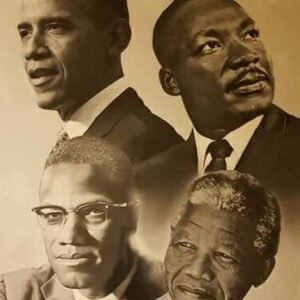School Desegregation – 1954…

The attempt to end the practice of separating children of different races into distinct public schools.
Beginning with the landmark Supreme Court case of BROWN V. BOARD OF EDUCATION, 347 U.S. 483, 74 S. Ct. 686, 98 L. Ed. 873 (1954), the United States’ legal system has sought to address the problem of racial SEGREGATION, or separation, in public schools. In Brown, a unanimous Supreme Court found that segregating children of different races in distinct schools violates the Equal Protection Clause of the FOURTEENTH AMENDMENT, which guarantees that “[n]o state shall deny to any person the EQUAL PROTECTION of the laws” ( 1). In writing the Court’s opinion, Chief Justice EARL WARREN stressed the crucial role education plays in socializing children, and he maintained that racial segregation “generates a feeling of inferiority” in children that will limit their opportunities in life. A related decision, Brown v. Board of Education, 349 U.S. 294, 75 S. Ct. 753, 99 L. Ed. 1083 (1955), (Brown II), empowered lower courts to supervise desegregation in local school districts and held that desegregation must proceed “with all deliberate speed.”
A number of Supreme Court decisions in the decades since Brown have further defined the constitutional claims regarding desegregation first set forth in Brown. In many cases, these decisions have resulted in court-imposed desegregation plans, sometimes involving controversial provisions for busing students to schools outside their immediate neighborhood. Despite such judicial actions, desegregation in the United States achieved mixed success. Although many more children attend school with children of other races now than in 1954, in numerous cities, racial segregation in education remains as high as ever. Faced with the challenges of shifting populations, segregated housing patterns, impatient courts, and the stubborn persistence of racism, comprehensive school desegregationlong a hoped-for remedy to past discrimination against African Americansremains an elusive goal.
Brown and Brown II inspired a great deal of hope that the races would soon be joined in public schools and that the United States would take a giant step toward healing the racial animosities of its past. THURGOOD MARSHALL, an African American who led the National Association for the Advancement of Colored People’s Legal Defense Fund in its challenge to school segregation in Brown and later became a justice of the Supreme Court, predicted that after Brown, schools would be completely desegregated within six months.
Marshall’s statement proved to be wildly optimistic. By 1964, ten years after Brown, a Department of Health, Education, and Welfare (HEW) study indicated that only 2.4 percent of African Americans in the South were attending largely white schools. Such statistics indicated that Brown had led to only token INTEGRATION. By the mid-1960s, many observers felt that the Supreme Court, and the United States as a whole, had lost an opportunity to more quickly create a desegregated society. De facto segregation (segregation in fact or actuality)as opposed to de jure segregation (segregation by law)remained a stubborn reality, and racism remained its leading cause. Whites who did not want their children attending school with children of another race found many ways to avoid desegregation, from gerrymandering school boundaries (adjusting school boundaries to their advantage) to manipulating school transportation and construction policies. And in a phenomenon dubbed white flight, many transferred their children to private schools or simply moved to suburbs where few, if any, nonwhites lived.
Congress joined the Supreme Court in its efforts to assist desegregation, by passing the CIVIL RIGHTS ACT OF 1964 (28 U.S.C.A. 1447, 42 U.S.C.A. 1971, 1975a to 1975d, 2000a to 2000h-6). Among its many features, the act authorized HEW to create specific guidelines with which to measure the progress of school desegregation. In 1966, for example, these guidelines called for specific levels of integration: 16 to 18 percent of AfricanAmerican children in all school districts must be attending predominantly white schools. The act also allowed HEW to cut off federal funding to school districts that did not meet integration guidelines. However, this punishment proved difficult to use as a means of enforcement.
In the mid-1960s, a judge on the Fifth Circuit Court of Appeals, JOHN MINOR WISDOM, issued a number of influential opinions that strengthened the cause of racial integration of schools. Wisdom’s rulings established that it was not enough simply to end segregation; instead, school districts must actively implement desegregation. In one of these cases, United States v. Jefferson Board of Education, 372 F.2d 836 (5th Cir. 1966), he wrote, “[T]he only adequate redress for a previously overt system-wide policy of segregation directed against Negroes as a collective entity is a system-wide policy of integration.” Wisdom’s ruling also detailed measures that the school district must take toward the goal of integration, including deciding how children were to be informed of the schools available to them for attendance, where new schools must be constructed, where transportation routes must run, and how faculty and staff were to be hired and assigned.
In 1968, the Supreme Court again addressed the issue of school desegregation, in Green v. County School Board, 391 U.S. 430, 88 S. Ct. 1689, 20 L. Ed. 2d 716, which dealt with the schools of New Kent County, a rural area in eastern Virginia. In its opinion, the Court acknowledged that the integration guidelines set forth in Brown II had not produced adequate results. School districts such as those of New Kent Countywhere in 1967, 85 percent of black children still attended an all-black schoolhad avoided meaningful integration. It was not enough, the Court argued, to simply end segregation and allow a “freedom-of-choice” planby which AfricanAmerican children supposedly had the freedom to attend predominantly white schoolsto be the only means of combining the races in an educational setting. In comments during Court hearings on the case, Chief Justice Warren noted that though the “fence” of outright segregation had been taken down, socially constructed “booby traps” still prevented most children from attending integrated schools.
In SWANN V. CHARLOTTE-MECKLENBURG BOARD OF EDUCATION, 402 U.S. 1, 91 S. Ct. 1267, 28 L. Ed. 2d 554 (1971), the focus of school desegregation shifted from largely rural school districts to urban ones, a change of scene that offered new challenges to desegregation. In the rural South before the Brown decision, blacks and whites lived largely in the same communities or areas, and requiring that their children attend the same neighborhood schools could resolve segregation. In urban settings, however, blacks and whites lived in different neighborhoods, so combining the two races in the same schools meant transporting children, usually by bus, to institutions that were often far from their homes.
In Swann, the Court took the final step toward making busing a part of school desegregation plans, by giving the lower courts power to impose it as a means for achieving integration. Swann involved the Charlotte-Mecklenburg School District, in North Carolina, a district in which African Americans made up 29 percent of the student body. After the Supreme Court’s decision in Green, a federal district judge ruled that the school district had not achieved adequate levels of integration: 14,000 of the 24,000 AfricanAmerican students still attended schools that were all black, and most of the 24,000 did not have any white teachers. The judge called for the adoption of a desegregation plan that involved busing 13,300 additional children at an initial start-up cost of over $1 million.
THE BUSING DEBATE
Busing is a plan for promoting school desegregation, by which minority students are transported to largely white schools and white students are brought to largely minority schools. It is intended to safeguard the CIVIL RIGHTS of students and to provide equal opportunity in public education. Busing is also an example of affirmative actionthat is, the attempt to undo or compensate for the effects of past discrimination. Such action is sometimes called compensatory justice.
Busing was first enacted as part of school desegregation programs in response to federal court decisions establishing that racial SEGREGATION of public schools violates the EQUAL PROTECTION CLAUSE of the FOURTEENTH AMENDMENT to the Constitution. In Green v. County School Board, 391 U.S. 430, 88 S. Ct. 1689, 20 L. Ed. 2d 716 (1968), and SWANN V. CHARLOTTE-MECKLENBURG BOARD OF EDUCATION, 402 U.S. 1, 91 S. Ct. 1267, 28 L. Ed. 2d 554 (1971), the Supreme Court established that federal courts could require school districts to implement busing programs as a means of achieving racial INTEGRATION of public schools.
However, busing was nothing new in U.S. education. Even before these decisions, nearly 40 percent of the nation’s school children were bused to school. And before 1954, when the Court declared racial segregation in public schools unconstitutional in BROWN V. BOARD OF EDUCATION, 347 U.S. 483, 74 S. Ct. 686, 98 L. Ed. 873, children were often bused to segregated schools that were beyond walking distance from their homes.
With the Supreme Court decisions in Green and Swann, busing became one of the most controversial topics in U.S. law and politics, particularly in the 1970s. Although the zeal for busing as a remedy for past racial injustice had waned greatly by the 1990s, busing remained a featureif many times a limited oneof most school desegregation programs and continued to inspire heated debate.
Those who are in favor of busing claim, as did the Supreme Court in Green and Swann, that racial integration in and of itself is a worthy social goal and that busing is an effective means of achieving that goal in public education. Supporters point to the harmful legacy of segregation in education. Before Brown, African-American children were schooled in separate facilities that were usually inferior to the facilities used by whites, despite official claims that they were equal. Such segregation worked to keep African Americans at a disadvantage in relation to whites. It instilled feelings of inferiority in AfricanAmerican children and seriously diminished their educational achievement and opportunities.
Supporters of busing also often claim that de facto (actual) segregation exists even decades after the CIVIL RIGHTS MOVEMENT and the striking down of racial segregation laws, which occurred in the 1960s. A largely white, wealthy upper class and a largely minority, poor under-class, they argue, are transported, employed, housed, and educated in different settings. Often wealthy people live in the suburbs, and the poor live in the cities. Growing up in their separate neighborhoods, children from higher socioeconomic levels thus have many advantages that poorer children do not: more space at home, better nutrition and HEALTH CARE, greater cultural and intellectual stimulation, and friends and acquaintances with higher social status providing better job and career prospects. Some even compare the isolation of impoverished minorities in the United States’ inner cities with that of impoverished blacks under South Africa’s former apartheid system.
Advocates of desegregation through busing assert that these existing inequalities must not become greater and that desegregation in education will go a long way toward ending them and creating a more just society. They also point out that U.S. education has historically worked to ensure a society in which class hierarchy is minimized and social mobilityboth upward and downwardis maximized. Busing, they argue, will therefore help avoid the creation of a permanent underclass in the United States.
Supporters of busing also maintain that it is an affordable way to achieve school desegregation. While admitting that the initial start-up costs of a busing program can be large, they point to statistics that indicate the operating costs of compulsory busing are generally less than five percent of a school district’s entire budget.
Those who oppose busing make a variety of different points against it, although they do not necessarily oppose integration itself. Opponents claim that busing serves as a distraction from more important educational goals such as quality of instruction. Busing, they hold, too easily becomes a case of form over substance, in which the form of racial integration of education becomes of greater value than the substance of what is actually taught in schools. Critics of busing would rather focus on the environment in a school and in its classrooms than on achieving a particular number of each race in a school. Justice LEWIS F. POWELL JR. echoed these sentiments in an opinion to a school desegregation case, Keyes v. Denver School District, 413 U.S. 189, 93 S. Ct. 2686, 37 L. Ed. 2d 548 (1973). In Keyes, he wrote that in an era of declining student achievement, it is wrong to turn the attention of communities “from the paramount goal of quality in education to a perennially divisive debate over who is to be transported where.”
Critics also claim that busing causes white flightwhere whites move their children from integrated public schools to private and suburban schools that are largely whitewhich results in an even greater disparity between white and black, rich and poor. According to this scenario, busing only exacerbates the current situation, making public schools and cities even more the exclusive province of the poor.
Some noted experts on the issue of busing have concluded that although they favor a society that is racially integrated, the social costs of busing and the resulting white flight are too high. Others have sought a middle ground on the issue by arguing that judges should choose carefully the districts in which they decide to implement busing. For example, they claim that white flight is more likely to occur in communities and schools where whites form a small minority, and that as a result, busing has higher social costs in such districts.
Another prominent complaint in the anti-busing opinion is that court-ordered busing programs represent an abuse of judicial power. According to this view, busing is an example of undesirable judicial activism. The large-scale social changes caused by transporting thousands of children many miles each day should be imposed only by an elected body of representatives such as a state legislature or Congress. Moreover, adherents of this view argue that supervising school desegregation programs only bogs down the courts and takes time away from other pressing legal matters.
Critics of busing also point out that many times, the same court that requires busing does not provide guidance as to funding it, thereby creating financial headaches for school districts. Related to this issue is the claim that busing is too costly, especially when school districts are forced to purchase new buses in order to start a busing program. In financially strapped school districts, spending on busing sometimes takes away funding for other educational priorities.
cited:http://law.jrank.org/pages/10023/School-Desegregation-1970s-Swann-Busing.html <a href=”http://law.jrank.org/pages/10023/School-Desegregation-1970s-Swann-Busing.html”>School Desegregation – The 1970s: Swann And Busing</a>
Food for thought!!!! Rev. Earnest Mason






























